|
A (Modeling) Fight To The Death:
Building Combat Models' 1/48 scale
Martin P4M “Mercator”
by
"Bondo" Phil Brandt
|
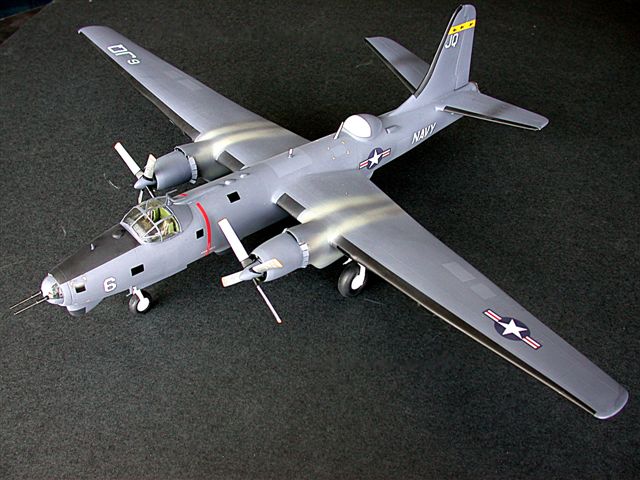
|
|
Martin P4M “Mercator” |

HyperScale is proudly supported by Squadron.com
Background
The graceful-but-little-known (only nineteen airframes were completed) Martin P4M “Mercator” followed the much more ubiquitous and much longer lived P2V Neptune into Naval service in the late Forties. Originally designed as a long range patrol and mine layer for the planned 1946 invasion of the Japanese mainland, the Mercator in the Fifties morphed into a valuable ELINT asset (the P4M-1Q), so valuable that at least two were attacked by Communist forces over international waters; one was lost to Chinese fighters and one managed to land in Japan after being badly damaged by North Korean Migs.
The large airframe (1/3 larger than the P2V) Mercator was notable for combining piston power (two huge R4360s) with two J33 jet engines. A J33 was mounted in each 4360 nacelle, behind and below. The successful blend of piston and jet power enabled the Mercator to attain speeds as fast as some contemporary fighters.
P4Ms soldiered for over a decade until relieved by the A3D Skywarrior in 1960. Sadly, no Mercator airframes were retained for museum display.
My first contact with the Mercator was when, circa 1951, I scratchbuilt a large planked-balsa control-line P4M from plans in Air Trails Magazine. I never flew it, but I do remember covering the entire exterior with doped-on nylon courtesy of my mother’s old stockings!
The Kit
Well, boys and girls, this is where the Bondo “legend” began. Roughly fifteen years ago I bought the Combat Mercator kit from a vendor at our annual Austin show. As I walked in front of good friend Mike West’s Lone Star Models vendor table “The Resin Prince of Sugar Land” spotted the kit under my arm, and knowing the amount of putty that would need to be applied to said kit, piped up with a loud, “Bondo Phil”! The nickname stuck, and, playing along with the joke, yours truly later embellished it by inventing “Bondo Industries.” But, I digress.....
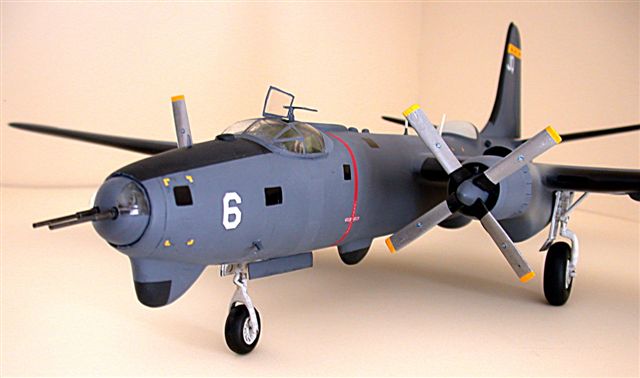
The Combat Models vacuform Mercator, although one of the few Combat releases to have engraved–and I use that term loosely here–panels, has all the other negatives with which grizzled vets of this firm’s genre are familiar: thin plastic, incorrect profiles, no landing struts, no cockpit details, barely acceptable clear parts, little/poor documentation, and construction plans ripped off from other publications, in this case the three-views seen in Steve Ginter’s excellent , and practically mandatory, Mercator Book.
The name of the game in building a Combat offering is that the “kit” is actually just an exoskeleton, albeit a thin one, of the basic airframe shape. You, the modeler, get to add everything else via a bumpy ride through Scratchbuild City. The excellent Esoteric Models 1/72 vacuform Mercator, also in the Bondo Industries stash, is everything the Combat release is not. But, this curmudgeon’s always loved 1/48, sooo it was suck-it-up time at the El Rancho Loafo.
Fuselage
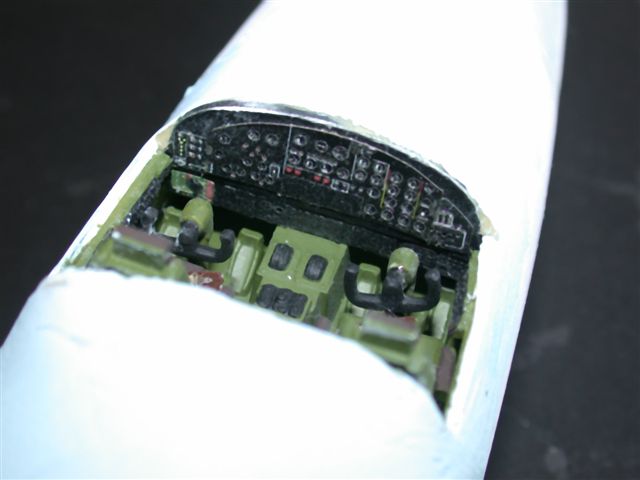
The aforementioned thin plastic makes internal bracing a must; sheet plastic fuselage formers and cockpit flooring went a long way in “firming” things up. Especially difficult was the forward gun turret fabrication. The cockpit was mostly scratchbuilt using cannonballed C-130 seats and consoles, homebrew sidewalls/coaming and an Eduard B-17 color etch instrument panel and WWII color-etch belts (hey, it works!).
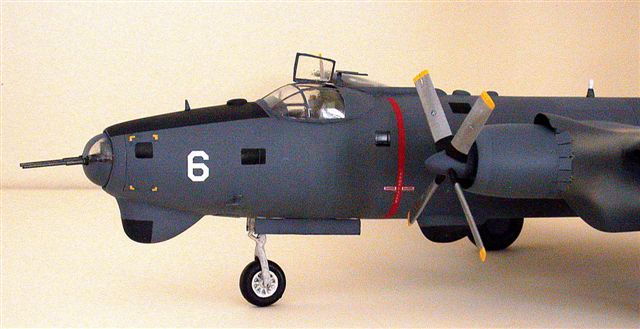
The large vac’ed canopy as furnished is way oversized, heightwise. Substantial, but judicious, trimming of the lower edge created a much more svelte one as seen in pix. The opened canopy hatch resulted when, to my horror after unmasking the painted canopy, there was residue from extensive wetsanding halfway up the inside of the windscreen! By opting for an opened hatch (as seen in pix of the real deal) I was able to insert dampened Q-tips to remove the unsightly film.
The ELINT bulges on the bottom are from the kit, but the large, late-model ADF on the upper empennage was scratchbuilt with formers and A&B epoxy putty. Same, same for the avionics fairings and antennas just aft of the canopy. Your correspondent was growing fairly tired as the project dragged on, and he decided to forego the scratchbuilding of the eight windows that grace the forward fuselage, opting--our AMS-infected brethren would probably say “wussing-out”--for the old gloss black paint routine instead.
Wings
Although the gracefully long Mercator wingspan would seem to call for serious bracing, I found that CA-ing lengths of plastic angle stock along the wingspan was sufficient, especially since the weight-bearing gear wells are well inboard. Combat predictably–Esoteric didn’t!--fudged on the Mercator’s unique double airfoil wings (slow speed, “fat”, airfoil on the inboard section, sleeker highspeed airfoil outboard) making it necessary to scratchbuild the extended outer leading edges; lotsa fun!
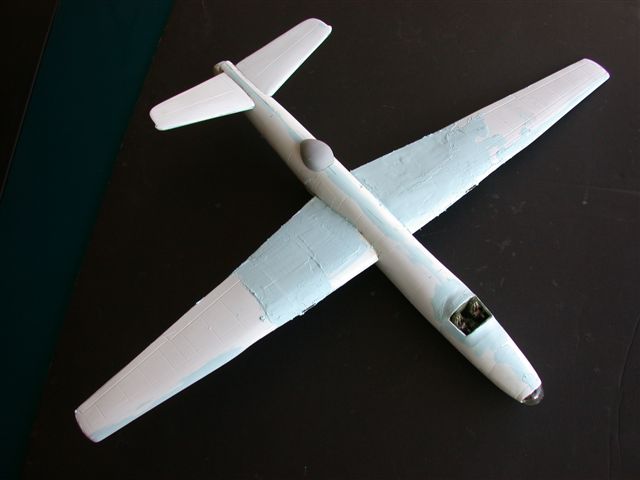
The dihedral that starts halfway out from the fuselage required industrial amounts of Blue Acryl, with drying times between applications of almost a week. I find that the ol’ sniff test is a good indicator of when it’s safe to slather on another putty layer. That is, when the dried Blue Acryl seems to be no longer “outgassing” lacquer fumes, it’s safe to squeegee on some more. Landing gear wells were cut out and redone with plastic sheet.
Engine Nacelles / Powerplants
The Combat-furnished cowlings were significantly undersize and wrongly profiled. I scratchbuilt a master cowling that could contain an Engine&Things R-4360 resin powerplant, and then cast two copies. Cooling flaps were scratched out of thin sheet, and exhaust stacks were fashioned out of angle-cut aluminum tubing.
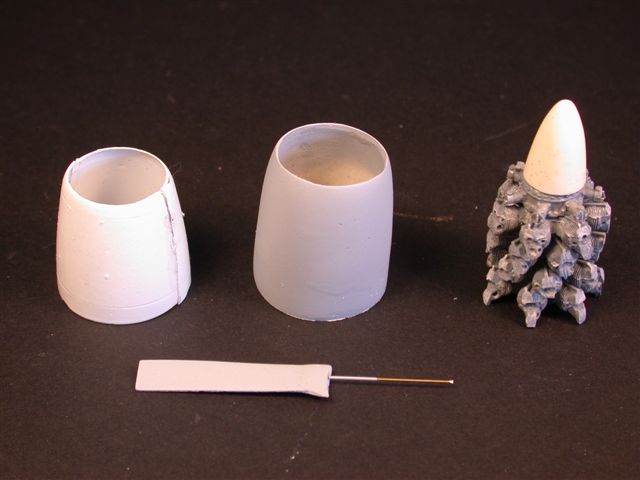
Props and spinners as furnished were a total loss too--the Combat props looked as if they’d been cloned from a 1/32 Corsair--and more correct ones were mastered and cast in resin. The jet exhausts were deepened to 1 ½ inches with plastic tubing.
Landing Gear
Using pix from the Ginter book, I chose Monogram B-24 maingear struts which, after lengthening 1/4 inch (to accept the large Mercator wheel/tire assembly), and with added braces, had a fair resemblance to that of the P4M. The nosegear strut was built totally from scratch, as were the main and nosegear wheel well doors .
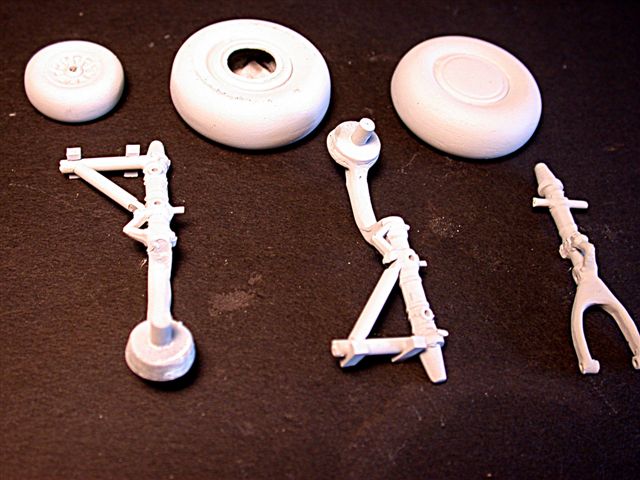
The wheel halves from the kit were filled with lead pieces and joined together. Although the vacuform airframe is fairly light, the lead-filled nosewheel was still not enough to bring the nose down, and I had to cut a hole just aft of the nosegear well to insert more lead sinkers.
Painting
 ELINT Mercators were originally finished in overall Seaplane Gray, slowly changing over to Dark Sea Blue in the late Fifties. ELINT Mercators were originally finished in overall Seaplane Gray, slowly changing over to Dark Sea Blue in the late Fifties.
I chose a gray bird of VQ-2, operating clandestine missions out of Port Lyautey, Morocco in 1959, as pictured in the great three-view artwork in Volume 19 of Wings of Fame.
Engine Gray Testors Acrylic was lightened with white until the shade “looked about right” compared with photos. An ever so lighter secondary gray tone was airbrushed over various panels for contrast in such a large airframe.
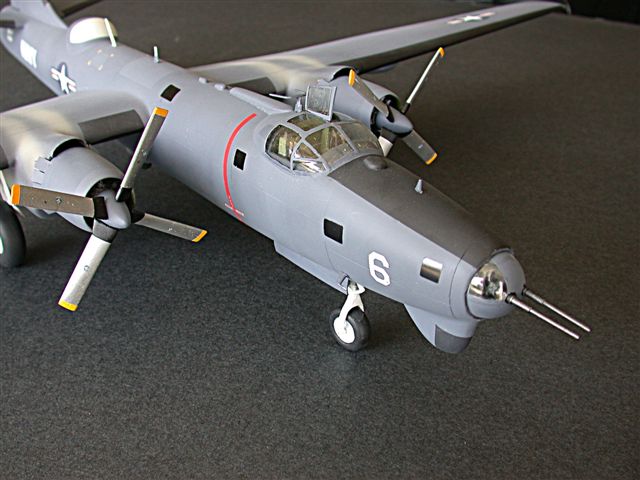
Tamiya Chrome Yellow lacquer in the spraycan was used for the horizontal stripe on the vertical fin. The exhaust stains might seem excessive, but based on the pix in Ginter, they’re just average!
Decals
Insignia and letters are by AeroMaster, and the small bat logos on the vertical fin’s yellow stripe were hand cut from black decal film. I’ve found that masking and shooting fuselage stripes, as opposed to laboriously laying down fragile decal stripes, is a more satisfying way to go, and the prop warning stripe was a no-brainer.
Bondo may not be good, but he’s slow! Having procrastinated for well over a decade on this interesting subject, I’m happy and at peace now that it’s finished. Plus, I can now not feel guilty in moving on to other subjects in the Weirdness Works Division of Bondo Industries.
The ol’ Mercator may not be a contest winner, but did I mention it’s done?
-
Wings of Fame Magazine, Volume 19, 2000, Aerospace Publishing, Aerospace ISBN 1 86184 049 7
-
Naval Fighters Number 37, The Martin P4M-1/-1Q Mercator, by Steve Ginter, 1996, ISBN 0-942612-37-X
Model, Images and
Text Copyright © 2008 by "Bondo" Phil Brandt
Page Created 08 July, 2008
Last Updated 08 July, 2008
Back to HyperScale
Main Page |
Home
| What's New |
Features |
Gallery |
Reviews |
Reference |
Forum |
Search